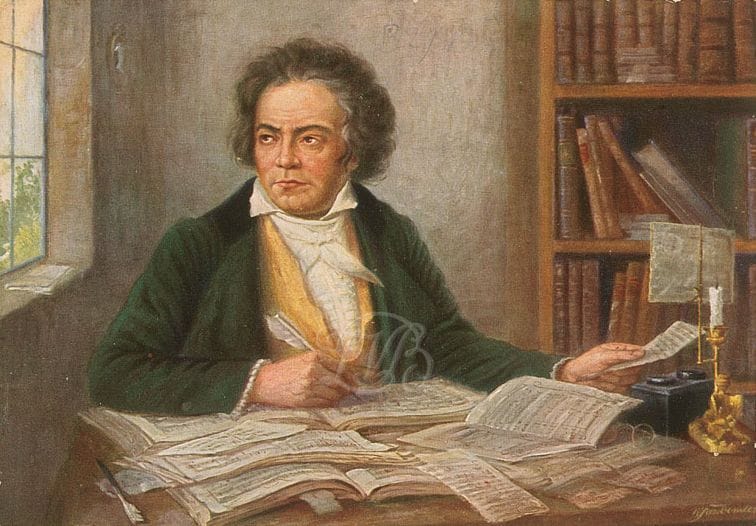Beethoven’s magnum opus

A brief history of the master’s most spectacular work: Symphony No 9. By Manohar Parnerkar
Beethoven’s most celebrated work, Symphony No 9 in D minor, Opus 125, also known as Beethoven’s Ninth, or simply as the Ninth, was revolutionary. In terms of sheer power, scale, complexity and overall impact, it surpassed all previous symphonies, including Beethoven’s earlier ones. For the first time in history, it attempted, spectacularly and successfully, a fusion of orchestral music with sung poetry. Apart from making a powerful social statement, it paved the way for the expansive symphonies of Beethoven’s near contemporary Franz Schubert, Johannes Brahms, and his two spiritual descendants, namely, Anton Bruckner and Gustav Mahler. It is no surprise then that in the last 100 years or so, the Ninth’s appeal has transcended boundaries, cutting across the political, cultural and ideological spectrum.
The facts
The Ninth was originally commissioned by the Philharmonic Society of London for £50, then a princely sum. However, Beethoven, presumably, to respect German sentiment and pride, dedicated it to King Friedrich Wilhelm III of Prussia. The symphony had its first public performance on 7th May, 1824 at the Kärntnertor Theatre in Vienna. There was no question of a totally deaf Beethoven conducting the performance of a staggering work like the Ninth, with its gigantic and extremely complex score running into some 296 pages. So its premier performance was conducted by Michael Umlauf, who had earlier conducted Fidelio, the only opera that Beethoven ever wrote.
This seminal work of musical romanticism is also called ‘Choral’ because it is partly sung. The Ninth has five movements of which the first four are purely orchestral. The fifth movement – the finale – incorporates verses from German poet Friedrich Schiller’s poem An die Freude (An Ode to Joy). The poem is sung by four solo voices, namely, a soprano, an alto, a tenor and a baritone, and a mixed chorus and, of course, played by a symphony orchestra. To dwell on the orchestral movements is clearly beyond the scope of this article. So let me instead offer the reader a few broad observations on the hybrid character of the Ninth. The symphony’s finale, a poem, does have an obvious extra-musical meaning. But this, by itself, does not make it a programmatic work like Beethoven’s Sixth Symphony (‘Pastoral’). Strictly speaking, its five movements, like those of the Pastoral, may not be organically connected, but they do bear a technical kinship of sorts. When music and poetry are brought together, one often tends to dominate the other. But nothing of the sort is happening here; the two mutually – and perfectly – fuse together and, in fact, go on to enrich each other.

The muse
So what is a poem doing in a symphony, and why Schiller’s Ode to Joy in particular? When 52-year old Beethoven conceived the Ninth, his deafness was close to total. By the time of its completion in 1824, it would become total. So this symphony is the creation of a profoundly introspective soul who now had to seek inspiration only from within. Apparently Beethoven wanted to say so much and so powerfully in his symphonic swansong that he felt orchestral resources alone would not be sufficient. This is why, it is generally believed, he turned to poetry, and inevitably to the most expressive instrument created by God – the human voice.
Friedrich Schiller was a quintessential Renaissance man – a poet, dramatist, historian, literary theorist and qualified surgeon. More to the point, he was arguably as great a poet of Germany as Goethe (who incidentally was well-acquainted with both Schiller and Beethoven). Besides being firm believers in the doctrine of the Enlightenment, Schiller and Beethoven also ardently shared the Masonic ideal of universal brotherhood and love. Schiller’s Ode to Joy talks fervently of the joy of living, loving, and of a world in which ‘all men become equal’. As a young man of 22, Beethoven was quite gripped by the poem, so 30 years later when he decided to fuse music with poetry in the Ninth, Ode to Joy must have suggested itself.
The finale
The finale, approximately 18 minutes long, has some profoundly moving passages, played and/or sung, which conjure up in your mind’s eye visions of heaven. Joseph Krips, the leading Austrian conductor of the 20th century, and a Beethoven-symphony specialist to boot, summed up his personal vision of the finale thus: ‘For me, the Choral finale simply does not take place here on earth. It is dangerous to talk specifically of one’s personal vision, but in my mind’s eye I see quite clearly the instant in which Beethoven enters Heaven. The finale tells us of his arrival, and how all of Heaven stands still in his presence.’
Over the years it has been observed that there is nothing particularly unique about Krips’s personal vision of the finale’s music. It produces more or less the same kind of heaven-centric vision in the minds and hearts of thousands of listeners – not all of them necessarily music-aficionados. This is indeed a testimony to its universal appeal.
The Symphony Orchestra of India will perform Beethoven’s 9th under the baton of Martyn Brabbins on 9th and 10th February at the Jamshed Bhabha Theatre.
This piece was originally published by the National Centre for the Performing Arts, Mumbai, in the December 2018 issue of ON Stage – their monthly arts magazine.





